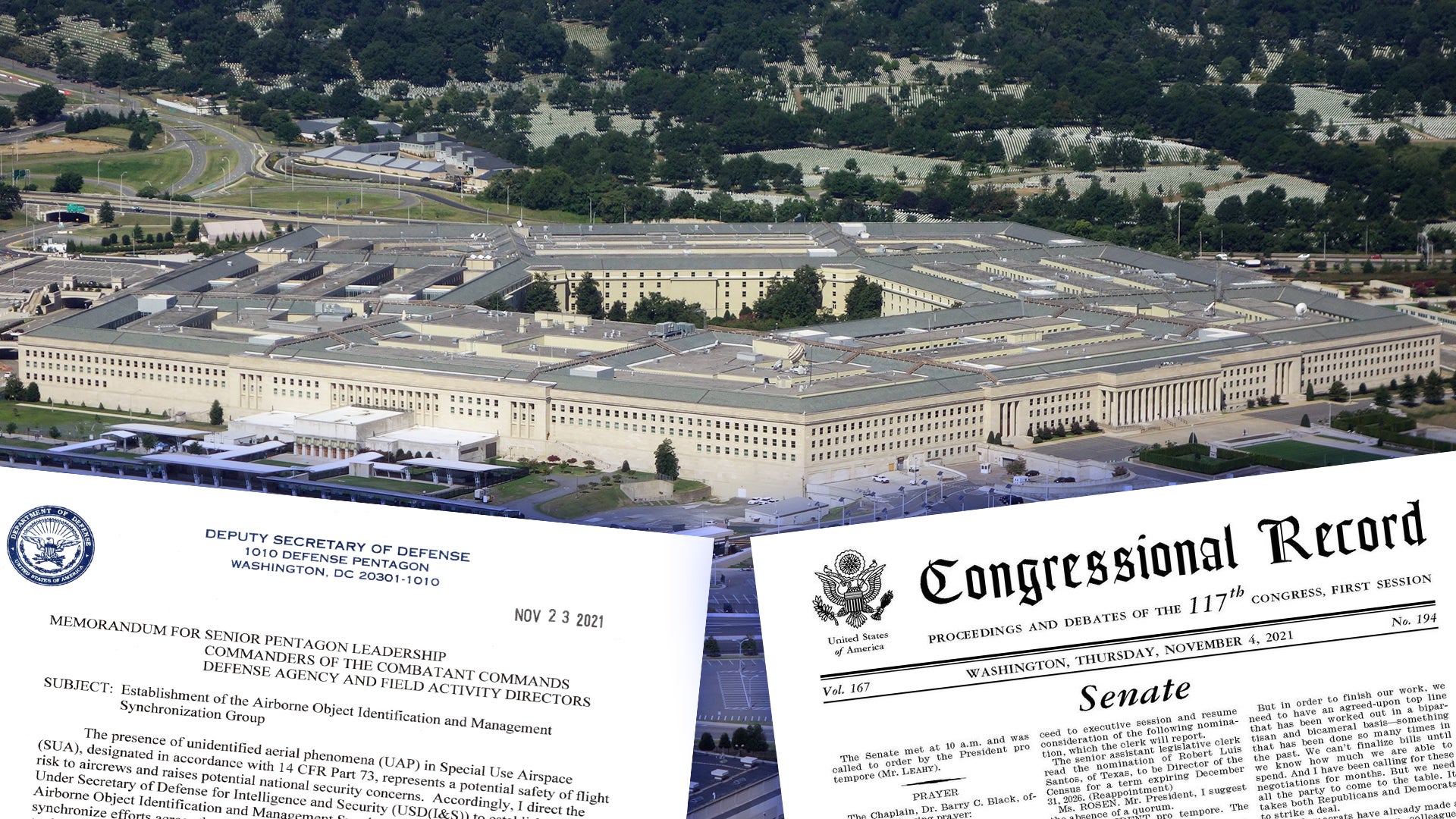Late last night, the Pentagon released a memorandum outlining the creation of a new organization focused on the issue of so-called unidentified aerial phenomena, or UAP, more commonly referred to as unidentified flying objects, or UFOs, and the threats they might pose to national security. This group will replace the existing UAP Task Force within the U.S. Navy and will be focused entirely on encounters in areas designated as Special Use Airspace, or SUA, such as warning areas off America’s East and West Coasts where many reported incidents have occurred in the past. Separately, a number of members of Congress are calling for the U.S. military to take much broader action, including in a proposed amendment to the Senate’s draft of the annual defense policy bill for the 2022 Fiscal Year.
Deputy Secretary of Defense Kathleen Hicks issued the memorandum, seen below, regarding the establishment of the Airborne Object Identification and Management Synchronization Group (AOIMSG) under the Office of the Undersecretary of Defense for Intelligence and Security, or USD(I&S), on Nov. 23, 2021. Though publicly available, the memo is specifically directed to senior Pentagon leadership, commanders of the U.S. military’s combatant commands, and defense agency and field activity directors. The latter category would include intelligence agencies within the Department of Defense, such as the Defense Intelligence Agency (DIA), National Security Agency (NSA), and National Geospatial-Intelligence Agency (NGA). A copy was also forwarded to the Director of National Intelligence (DNI), who oversees the U.S. Intelligence Community.
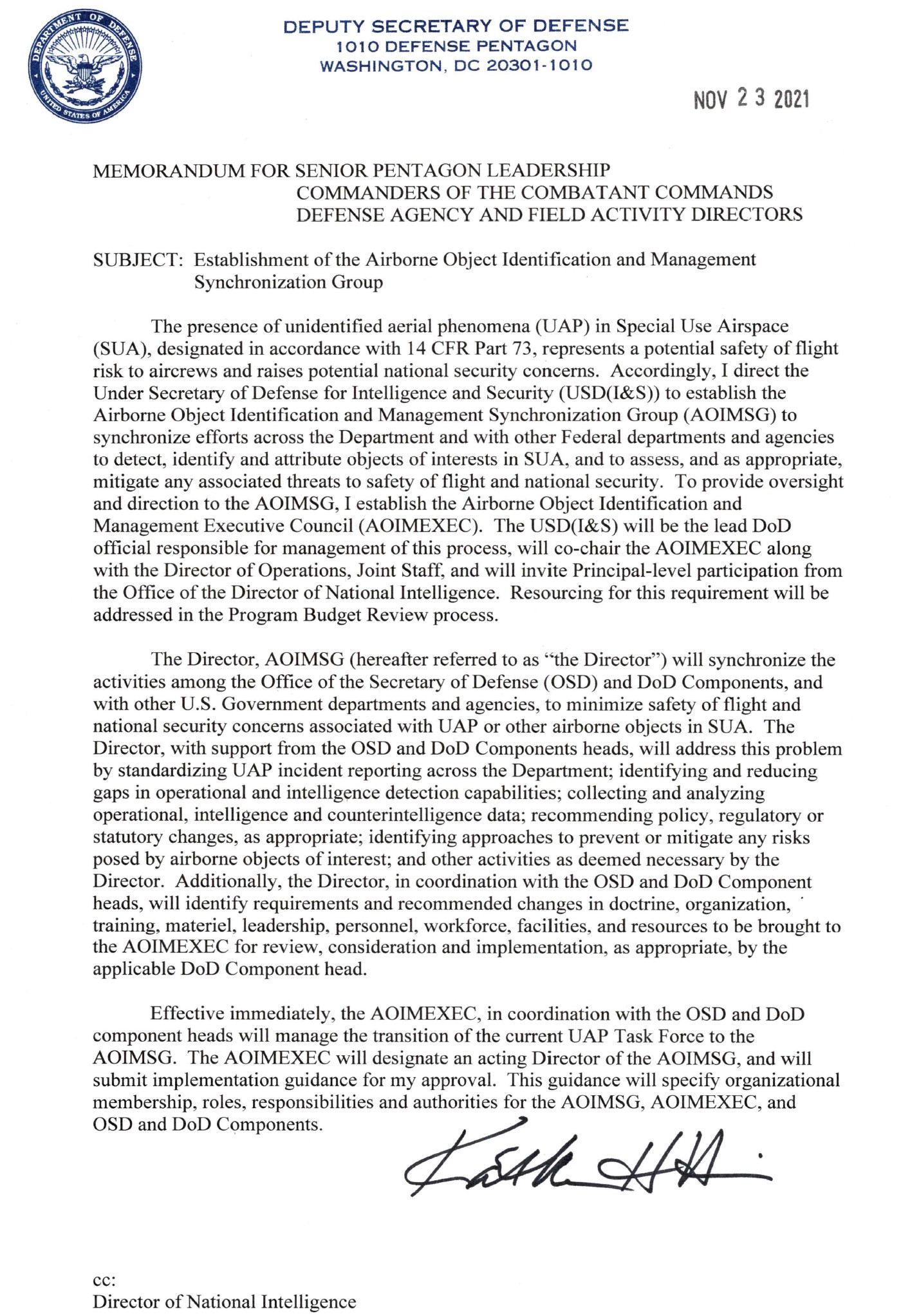
“The AOIMSG will synchronize efforts across the Department and the broader U.S. government to detect, identify and attribute objects of interests in Special Use Airspace (SUA), and to assess and mitigate any associated threats to safety of flight and national security,” according to an accompanying press release. “To provide oversight of the AOIMSG, the Deputy Secretary also directed the USD(I&S) to lead an Airborne Object Identification and Management Executive Council (AOIMEXEC) to be comprised of DoD and Intelligence Community membership, and to offer a venue for U.S. government interagency representation.”
Per the Federal Aviation Administration, Special Use Airspace “consists of that airspace wherein activities must be confined because of their nature, or wherein limitations are imposed upon aircraft operations that are not a part of those activities, or both” and includes, but is not limited to, “warning areas, MOAs [temporary military operations areas], alert areas, CFAs [controlled firing areas], and national security areas (NSA).” A significant number of publicly known UAP encounters reported by the U.S. military have taken place in warning areas off the coasts of the contiguous United States.
“Incursions by any airborne object into our SUA pose safety of flight and operations security concerns, and may pose national security challenges. DOD takes reports of incursions — by any airborne object, identified or unidentified — very seriously, and investigates each one,” the press release about Hicks’ new memo continues. “This decision is the result of planning efforts and collaboration conducted by OUSD(I&S) and other DoD elements at the direction of Deputy Secretary Hicks, to address the challenges associated with assessing UAP occurring on or near DOD training ranges and installations highlighted in the DNI preliminary assessment report submitted to Congress in June 2021. The report also identified the need to make improvements in processes, policies, technologies, and training to improve our ability to understand UAP.”
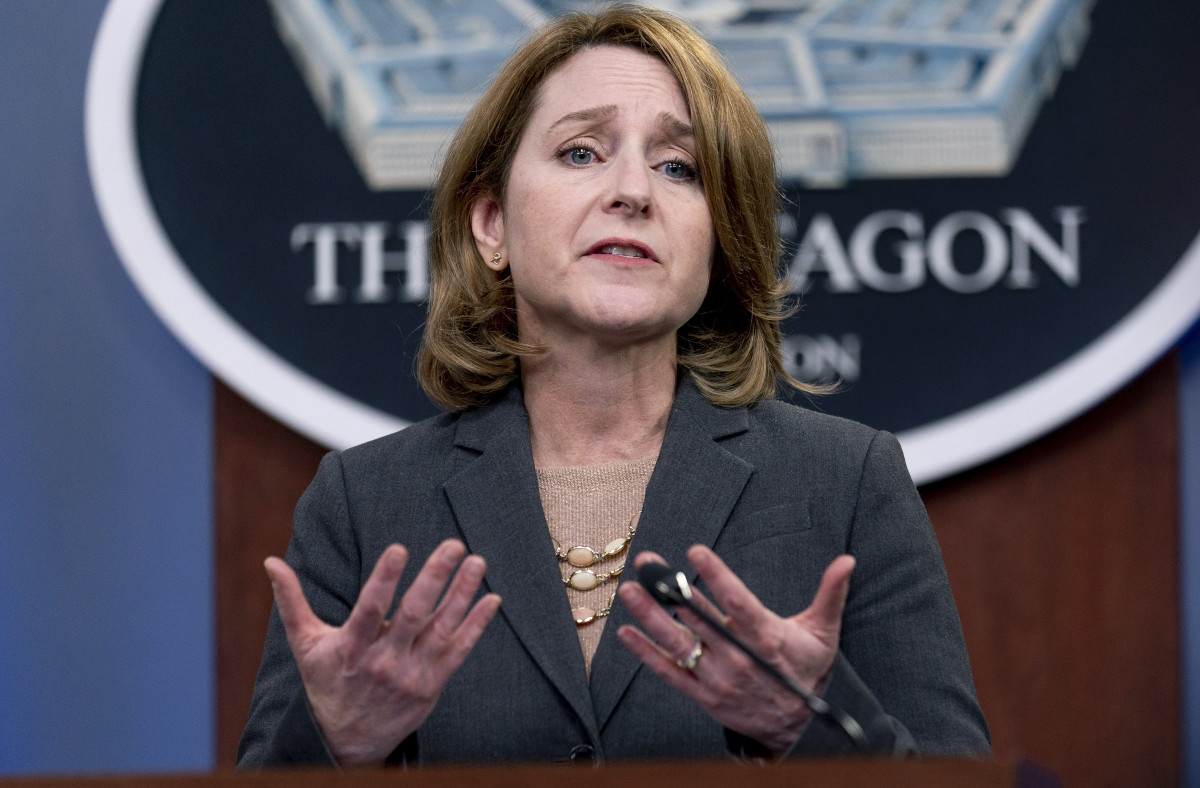
On June 25, the Office of the Director of National Intelligence (ODNI) had released a hotly anticipated public report on just what data the U.S. military and U.S. Intelligence Community had collected on UAPs, what had been done with that data so far, and the potential risks these objects might present to national security, as well as to basic flight safety. That report offered, at best, limited answers to a host of questions, and raised many more, as The War Zone
explored in depth at the time.
Shortly after that report’s release, Deputy Secretary of Defense Hicks issued another memorandum outlining plans to “formalize the mission currently performed by the UAPTF” and otherwise improve the “collection, reporting and analysis” with regards to the UAP issue.
Though buried at the end of the document, her new memo makes clear that the plan now is for the new AOIMSG to subsume this existing task force within the Navy’s Office of the Deputy Chief of Naval Operations for Information Warfare/Director of Naval Intelligence, or N2/N6. “Effective immediately, the AOIMEXEC, in coordination with the OSD [Office of the Secretary of Defense] and DoD component heads will manage the transition of the current UAP Task Force to the AOIMSG,” it says in its last paragraph.
The creation of the AOIMSG and the AIOMEXEC are certainly significant new responses on the part of the Pentagon to the matter of UAP incidents. The specific direction for the group to work to attribute these objects, that is to say identifying their origins and operators, is particularly important. There is a very likely possibility that a not insignificant number of the UAPs that U.S. military personnel have encountered so far are being controlled by hostile actors, including potential nation-state adversaries, such as China, something The War Zone
has outlined in great detail in the past.
At the same time, narrowing the scope of their activities to incidents in SUA can only impose limits on their work. This is in direct contrast to the actions that some members of Congress are trying to push the U.S. military to take through provisions in the forthcoming defense policy bill, or National Defense Authorization Act (NDAA), for the 2022 Fiscal Year.
One particularly notable amendment was initially put forward by Sen. Kirsten Gillibrand, a New York Democrat, on Nov. 4. It has since become commonly referred to as the Gillibrand Amendment. She has since refiled it three times, each with slight changes to the language. The first time, Sen. Marco Rubio, a Florida Republican, and Sen. Martin Heinrich, a New Mexico Democrat, also joined as cosponsors. The second time, Senators Roy Blunt and Lindsey Graham, Republicans from Missouri and South Carolina, respectively, added their names, as well.
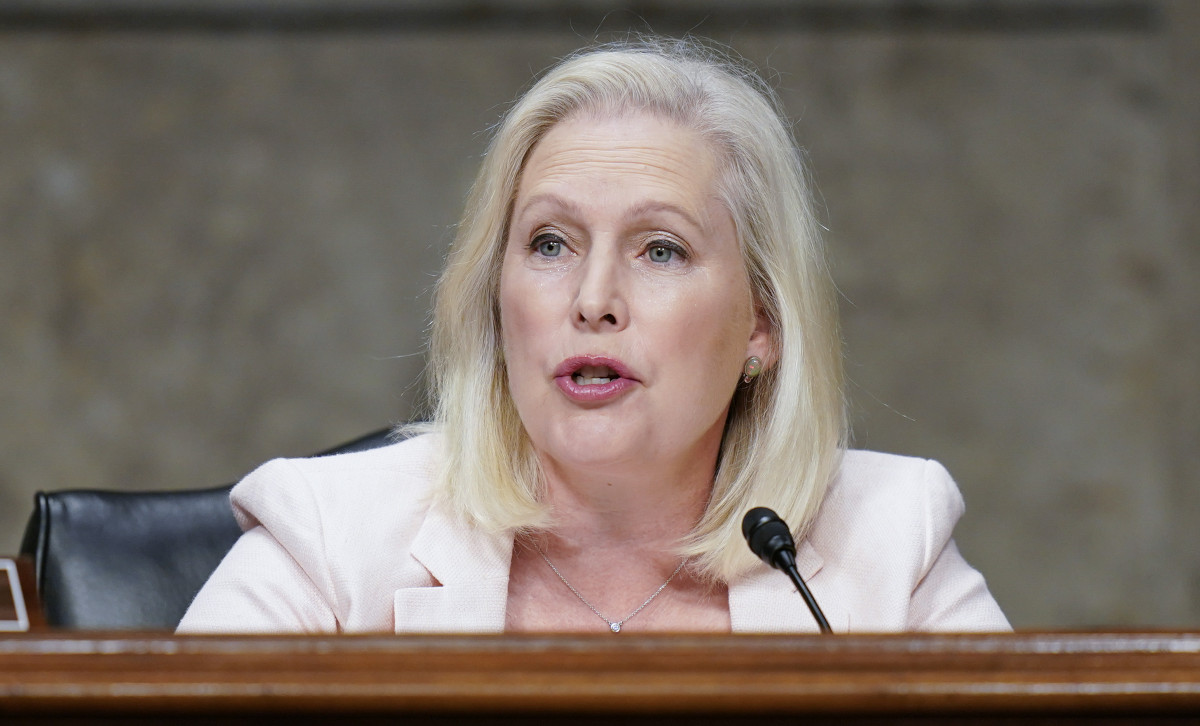
Rubio has already been one of, if not the most outspoken advocates for the U.S. government to take more action in response to UAPs due to the national security implications. He was the one who submitted, on behalf of the Senate Select Committee on Intelligence, the report accompanying a draft of the Intelligence Authorization Act (IAA) for Fiscal Year 2021 that demanded ODNI produce its preliminary UAP review. He has also been pushing to include provisions in the IAA for the 2022 Fiscal Year that would strengthen the UAPTF, which may now be moot given the Pentagon’s decision to shut that office down.
Among many things, the Gillibrand Amendment calls for the creation of organizations similar to AOIMSG and AOIMEXEC, but with much broader authority and that would be legally required to conduct more robust investigations into incidents and report their findings to Congress. What the amendment calls the Anomaly Surveillance and Resolution Office (ARSO) would be responsible for “developing procedures to synchronize and standardize the collection, reporting, and analysis of incidents, including adverse physiological effects, regarding unidentified aerial phenomena across the Department and intelligence community.” The individual in charge of it would be able to “propose, as appropriate, the use of any resource, capability, asset, or process of the Department and the intelligence community.”
The OSD and ODNI would be required to assign existing entities the task of conducting “field investigations” and to make sure that “the designated organization or organizations have available adequate personnel with requisite expertise, equipment, transportation, and other resources necessary to respond rapidly to incidents or patterns of observations.” ARSO itself would be called on to establish an entire scientific enterprise to “develop and test, as practicable, scientific theories to account for characteristics and performance of unidentified aerial phenomena that exceed the known state of the art in science or technology, including in the areas of propulsion, aerodynamic control, signatures, structures, materials, sensors, countermeasures, weapons, electronics, and power generation, and to provide the foundation for potential future investments to replicate any such advanced characteristics and performance.”
The Gillibrand Amendment also gives special attention to UAP encounters over military and civilian facilities and other assets that deal with nuclear weapons and nuclear power, “including strategic nuclear weapons and nuclear-powered ships and submarines” and nuclear power plants.
All this makes good sense, especially given concerns that UAPs might reflect significant technological advances on the part of adversaries, such as China, as well as just potential threats. The nuclear focus is also not surprising given that Navy nuclear-powered aircraft carriers and their aircraft have been at the center of many significant UAP reports in the past. Separately, there has been worrisome drone activity, which may account for many UAP sightings in general, around sensitive nuclear-related infrastructure, including nuclear power plants. The War Zone was first to report on a series of concerning and still-unexplained drone flights near the Palo Verde nuclear power plant in Arizona back in 2019, as well as still-unidentified aircraft swarming non-nuclear Navy destroyers off the coast of southern California that same year.
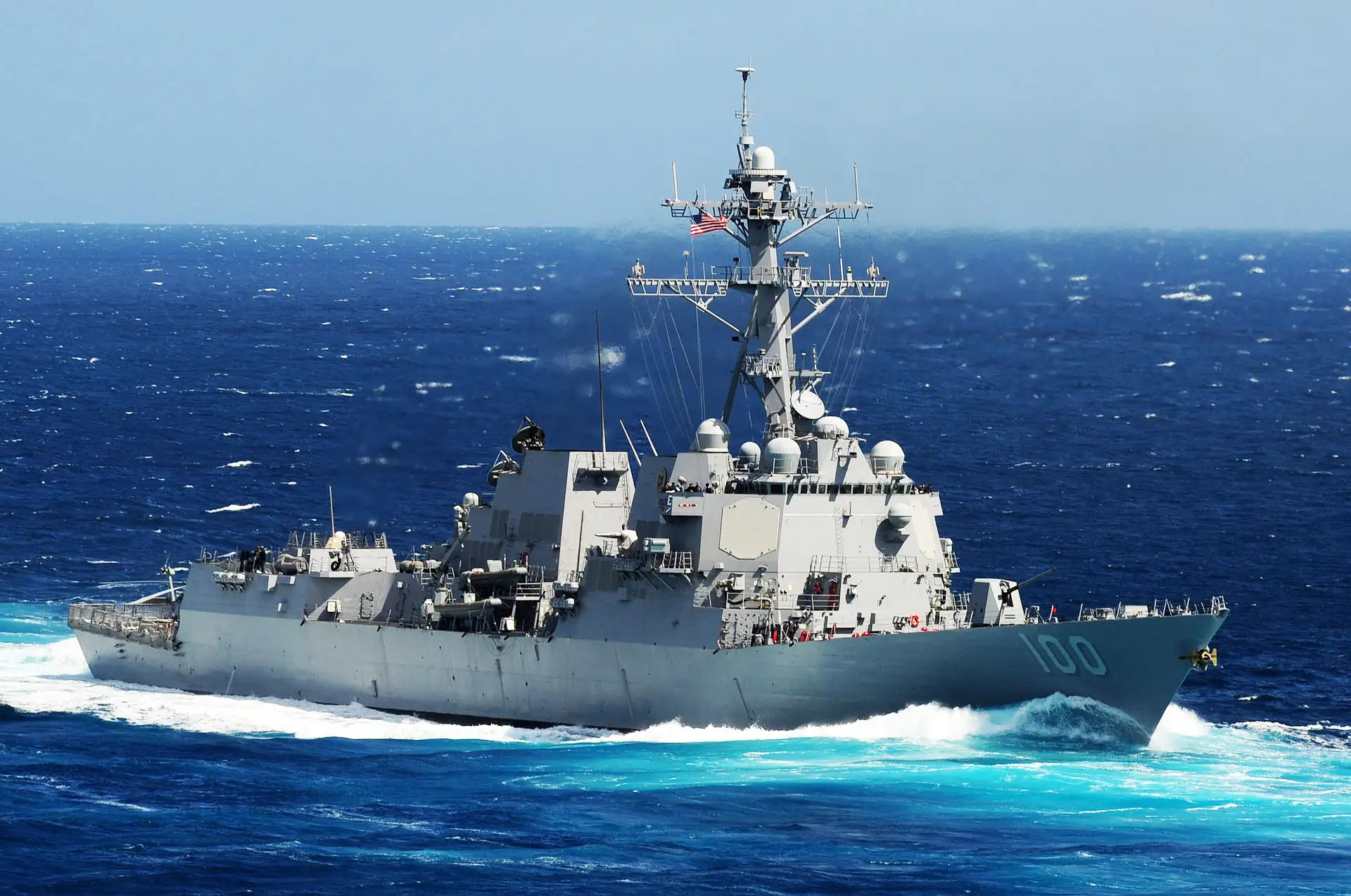
“You’re talking about drone technology, you’re talking about balloon technology, you’re talking about other aerial phenomena, and then you’re talking about the unknown,” Gillibrand told Politico in her first interview regarding her amendment last week. “Regardless of where you fall on the question of the unknown, you have to answer the rest of the questions. That’s why this is urgent. That’s why having no oversight or accountability up until now to me is unacceptable.”
In addition, Gillibrand’s proposed UAP-related additions to the NDAA are more robust and well-defined than similar language that the House of Representatives has included in its draft of the NDAA. Just today, Representative Ruben Gallego, an Arizona Democrat who crafted the House’s UAP provisions, said that her amendment “has more teeth” than his and that he would work with her directly going forward. He added that the new Pentagon UAP group does not obviate the need for additional legislation on the issue.
While the House passed its version of the NDAA in September, the Senate has yet to do so with its draft. Afterward, the two chambers will need to work together to reconcile the bills before a final vote. President Joe Biden would still then need to sign it into law for any UAP provisions to come into effect.
With the final NDAA language on UAPs still in flux, there has already been criticism about the Pentagon’s new plans for the AOIMSG and AOIMEXEC. There are concerns that the Department’s latest actions are an attempt to offer an alternative to something far more robust and harder to sideline like the Gillibrand Amendment. It is already widely understood that the existing UAPTF has been chronically under-resourced, with allegations that this has been part of a deliberate effort to bury the issue entirely. The Air Force, in particular, has been notoriously averse to publicly acknowledging this topic at all, and even in supporting internal efforts to get to the bottom of it, for instance.
It very much remains to be seen what the exact structure and responsibilities of Pentagon entities tasked with responding to the matter of UAPs will be going forward. Still, the Office of the Secretary of Defense is already taking some steps, while Congress continues to push for additional action on what everyone involved seems to increasingly understand to be a significant national security issue.
Contact the author: joe@thedrive.com
